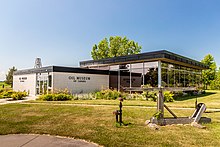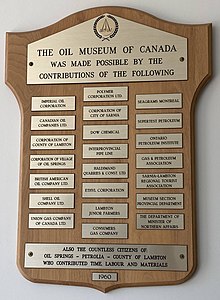Oil Museum of Canada
Oil Museum of Canada, National Historic Site, is a petroleum heritage museum in Oil Springs, Ontario. The museum is located on the site where James Miller Williams dug North America's first commercial oil well in 1858.[1][2] The land on and surrounding the museum, known as the "First Commercial Oil Field," is included in the List of National Historic Sites of Canada in Ontario.[3]
 The Oil Museum of Canada | |

| |
| Established | July 1, 1960 |
|---|---|
| Location | 2423 Kelly Road, P.O. Box 16 Oil Springs, Ontario, Canada N0N 1P0 |
| Coordinates | 42°46′24″N 82°07′15″W |
| Type | History museum |
| Website | https://www.lambtonmuseums.ca/oil/ |
History

Interest for an oil museum that paid tribute to Canada's early oil history in Lambton County began to surface in 1955 when Canadian Oil Companies Ltd. purchased the land where James Miller Williams established North America's first commercial oil well.[4][5] In 1957, a panel made up of members of the Lambton County Historical Society and the Oil Springs Centennial Committee developed plans for a $100,000 Museum that would preserve the site of the first commercial well and tell the stories of the oldest oil-producing area in North America.[6][4] The County of Lambton, Oil Springs and various local petrochemical companies financed the project, and Canadian Oil Companies Ltd donated William's former property to the museum committee.[7][6] Construction began in 1959, and the museum officially opened on July 1, 1960.[7][8] Lieutenant- Governor John Keiller MacKay hosted the museum's opening ceremony, noting that "we should hold an enduring reverence and respect for the pioneers, who laid the foundations for the oil development in this area." [8]
Collection
The Oil Museum of Canada's exhibits contain petroleum industry artifacts, historic photographs, geological displays and the souvenirs of the 'foreign drillers' who roamed the world in search of oil.[9] The outside exhibits include Canadian drilling rigs, a demonstration of the jerker line pumping system, a nineteenth century oil wagon and original buildings from the boom period.[9]
The Oil Museum of Canada's website includes a virtual exhibit that allows users to explore Lambton County's early oil history through the stories of Oil Springs and Petrolia's prominent historical figures.[10]
References
- "About Us - Oil Museum of Canada". Lambton County Museums. Retrieved 2020-06-23.
- "Oil Museum of Canada to Officially Open July 1". The Windsor Star. March 10, 1960.
- "First Commercial Oil Field National Historic Site of Canada". www.historicplaces.ca. Retrieved 2020-06-23.
- "$100,000 Project: April Start on Oil Museum". The Windsor Star. March 12, 1959.
- "Canadian Oil Companies Buys First Well Site". The Windsor Star. October 22, 1955.
- "Wait Word on Project: Plans Discussed for Oil Museum". The Windsor Star. November 22, 1957.
- "Clearing of Site Under Way: $100,000 Project to Show History of 'Black Gold'". The Windsor Star. May 14, 1959.
- "Mackay Opens Museum: Building Houses History of Oil in Lambton". The Windsor Star. July 2, 1960.
- "Permanent Exhibits - Oil Museum of Canada". Lambton County Museums. Retrieved 2020-06-23.
- "Black Gold: Canada's Oil Heritage". Lambton County Museums. Retrieved 2020-06-23.